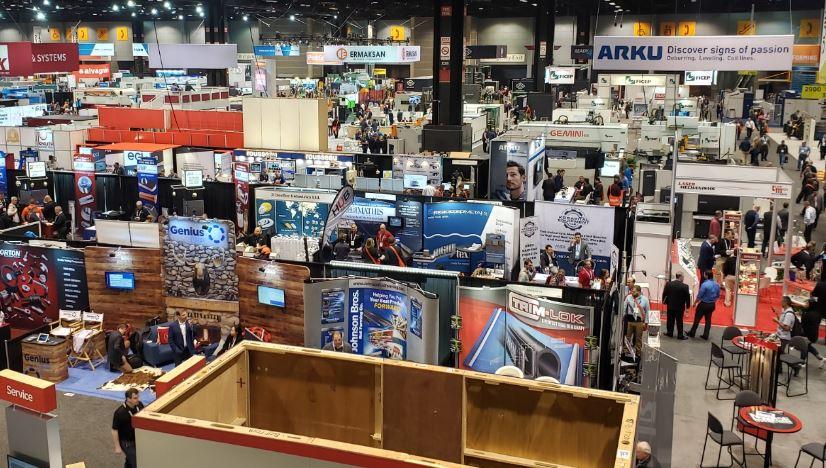Senior Editor
- FMA
- The Fabricator
- FABTECH
- Canadian Metalworking
Categories
- Additive Manufacturing
- Aluminum Welding
- Arc Welding
- Assembly and Joining
- Automation and Robotics
- Bending and Forming
- Consumables
- Cutting and Weld Prep
- Electric Vehicles
- En Español
- Finishing
- Hydroforming
- Laser Cutting
- Laser Welding
- Machining
- Manufacturing Software
- Materials Handling
- Metals/Materials
- Oxyfuel Cutting
- Plasma Cutting
- Power Tools
- Punching and Other Holemaking
- Roll Forming
- Safety
- Sawing
- Shearing
- Shop Management
- Testing and Measuring
- Tube and Pipe Fabrication
- Tube and Pipe Production
- Waterjet Cutting
Industry Directory
Webcasts
Podcasts
FAB 40
Advertise
Subscribe
Account Login
Search
FABTECH and the power of asking, What if?
Those who can connect the dots will reap the rewards
- By Tim Heston
- UPDATED November 13, 2019
- November 13, 2019
Every FABTECH, when I meet with exhibitors, chat, and talk about a technology’s potential, I ask myself, “What if?” What if cobots could weld? Now they can. What if new cutting and pick-and-place technology makes reliable cut-part sorting a reality? It’s now a reality. What if robots could program themselves in certain scenarios? Now they can.
Now, my “what ifs” are becoming grander, and several game-changing technologies here at the show might make those “what ifs” a reality. One is new vision technology that allows humans and robots to work next to each other, effectively turning every robot in a plant—even those with massive payload capacity—into a collaborative robot. Yesterday I spoke with Patrick Sobalvarro, CEO of Veo Robotics, who sees this technology one day using such a vision system “umbrella-ing” an entire shop floor.
Imagine a day where a standard robot sits atop an automated guided vehicle, picks sorted parts after the laser, and transports them to the next operation, a robotized bending operation where the robot essentially teaches itself how to bend.
Yesterday Bystronic showed its new compact bending cell, connected to a small, low-tonnage press brake, in which software reads the 3-D CAD file and creates a new bending program effectively on-the-fly. The robot moves slowly in an initial “trial run,” then moves as normal to bend the rest of the batch.
The press brake forms with real-time angle measurement. But just imagine if that angle measurement wasn’t needed? That would require perfectly consistent material, which doesn’t exist … right?
Not so fast. Here at the show, MetaLi, a startup launched out of work from UCLA, has introduced nano-material-infused metal. At present it’s focusing on welding consumables that can weld the unweldable material that would previously crack during cooling. But the material UCLA has created is effectively “engineered” with nano-sized ceramics that control the material grain to meet a certain need, be it welding or, perhaps in the future, stamping, bending, and various types of thermal cutting, from oxyfuel to the laser.
Monitoring all this in our hypothetical shop of the future would be machine learning and artificial intelligence. No longer would a laser break unexpectedly, thanks to widespread predictive maintenance that communicates machine and production data to enterprise-wide software, and perhaps even to “data aggregators” that analyze data from hundreds of fabricators, all in a quest to make artificial intelligence more intelligent than ever before.
Walking the show floor, it’s easy to imagine. Then I stop by a booth, and I realize my imagination is now reality, or at least has the potential to become reality in the not-too-distant future. That’s at the heart of what makes FABTECH so great.
subscribe now

The Fabricator is North America's leading magazine for the metal forming and fabricating industry. The magazine delivers the news, technical articles, and case histories that enable fabricators to do their jobs more efficiently. The Fabricator has served the industry since 1970.
start your free subscriptionAbout the Author

Tim Heston
2135 Point Blvd
Elgin, IL 60123
815-381-1314
Tim Heston, The Fabricator's senior editor, has covered the metal fabrication industry since 1998, starting his career at the American Welding Society's Welding Journal. Since then he has covered the full range of metal fabrication processes, from stamping, bending, and cutting to grinding and polishing. He joined The Fabricator's staff in October 2007.
Related Companies
- Stay connected from anywhere

Easily access valuable industry resources now with full access to the digital edition of The Fabricator.

Easily access valuable industry resources now with full access to the digital edition of The Welder.

Easily access valuable industry resources now with full access to the digital edition of The Tube and Pipe Journal.
- Podcasting
- Podcast:
- The Fabricator Podcast
- Published:
- 04/16/2024
- Running Time:
- 63:29
In this episode of The Fabricator Podcast, Caleb Chamberlain, co-founder and CEO of OSH Cut, discusses his company’s...
- Industry Events
16th Annual Safety Conference
- April 30 - May 1, 2024
- Elgin,
Pipe and Tube Conference
- May 21 - 22, 2024
- Omaha, NE
World-Class Roll Forming Workshop
- June 5 - 6, 2024
- Louisville, KY
Advanced Laser Application Workshop
- June 25 - 27, 2024
- Novi, MI
































